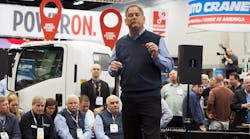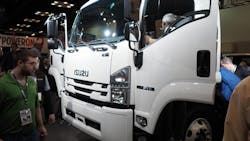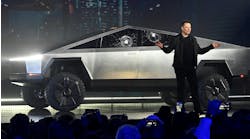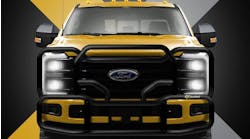Isuzu: 'Game-changing' new 2018 Class 6 medium duty in tune to population trends
INDIANAPOLIS. With a healthy dose of panache, Isuzu Commercial Truck of America, Inc. unveiled a new entry in the Class 6 medium-duty truck segment: the 2018 Isuzu FTR. The company made the announcement Wednesday afternoon at NTEA's 2016 Work Truck Show.
Perhaps very telling was that a number of Isuzu executives came from Japan to attend the press conference. That included Toshihiro Uehara, senior executive officer, and Yasuyuki Niijima, associate division executive for international sales.
The F-Series truck is slated to go into production in the United States in mid-2017, according to Isuzu. Shaun Skinner, executive vice president and general manager of Isuzu Commercial Truck of America, noted that this year marks Isuzu's centennial anniversary and that the company is Japan's largest commercial vehicle manufacturer.
Skinner also pointed out a number of trends the company sees going forward that are creating a market favorable to the new truck:
• The population of working-age adults will increase dramatically between now and 2050, the end of the century and beyond.
• Unlike post-WWII population growth, these adults "won't be fleeing for the suburbs."
• Instead, cities — especially those with more than 1 million residents — will see much of the growth.
• There will be steady, sustained market growth in the medium-duty commercial truck market "at least through 2021."
• Meanwhile, there's been a big decrease in truck drivers, "and within five years, we'll need 100,000 more drivers than we have today."
"Where will we need them, and more importantly, what will they need to be driving?" Skinner asked. "This is where we see increasing needs for a truck that can handle urban pickup and delivery, offers excellent fuel economy and offers low cost of ownership.
"This truck represents our vision of the future of the medium-duty truck industry," he added. Assisting the FTR in urban environments is the truck's max steer wheel angle: "With a 50-degree wheel cut, there's not a truck in this class with a tighter turning radius," Skinner said.
The FTR will be powered by Isuzu's 4HK1-TC 5.2L turbocharged four-cyl. diesel engine, a first in the segment. "As fuel economy and emissions regulations become stricter, you're going to see more and more competitors in this class turning to four-cylinder engines," Skinner said, noting that this is Isuzu's particular expertise.
Horsepower and torque ratings have not been finalized, but the company notes that the 4HK1 engine "is well known for its high torque output." The new truck will get an Allison 2000 Series automatic transmission and the engine will have a B10 durability of 310,000 miles, meaning that 90% of engines should reach that mileage before requiring an overhaul.
The FTR will be able to operate for extensive cruising distances, according to Isuzu, because of its "miserly" use of fuel and available aluminum 50- or 100-gal. fuel tank. Eight wheelbase configurations will accommodate bodies from 16 ft. to 30 ft., allowing for various body applications.
The company says it will release pricing, configurations, power ratings and additional features and specifications in mid-2017.





